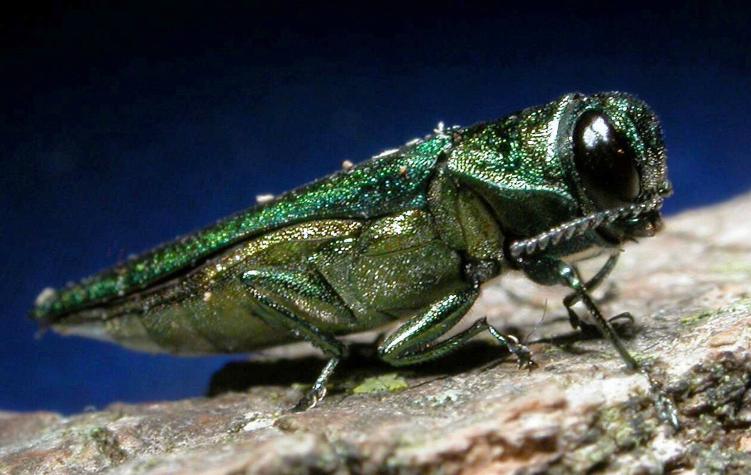Early treatment improves chances of survival.
COLUMBIA, Mo. – The invasive emerald ash borer may eliminate the ash tree from North America. In Missouri, EAB is present in 89 counties and the city of St. Louis.
“Just like the Dutch elm disease that killed our native American elm trees, EAB is capable of eliminating all ash trees from our forests and cities,” says University of Missouri Extension entomologist Kevin Rice. “This makes it one of the most serious threats now facing North American forests.”
EAB is a small, metallic green beetle native to Asia. It often spreads to new areas by hitchhiking on firewood transported by humans. The larvae feed under the bark of ash trees, cutting off the tree’s circulatory system. Tree death results within a few years.
Rice is investigating if tiny wasps can help reduce EAB populations. The parasitoid wasps, which only attack EAB larvae, were released in Missouri three years ago. Rice and his team are looking at climate and habitats where the wasps successfully establish and reduce EAB populations. They have field sites across Missouri, Iowa and Minnesota.
The shade tree is popular for landscaping. On average, about 14% of trees lining streets in urban settings are ash.
Tree owners should watch for signs of infestation, Rice says. Look for dead branches, especially in the upper third of the tree, and D-shaped exit holes in the bark. Increased activity by woodpeckers might mean larvae are under the bark. Trees can be protected with insecticides before they experience 40% dieback. But treatments will need to be administered every few years, says Rice.
Ash trees also make up a large portion of Missouri forests and provide wood for baseball bats and furniture. The loss of ash trees hurts the forest ecosystem and allows the spread of invasive weeds.
Rice suggests the following:
• Consider which trees are worth saving. Remove damaged or poorly placed trees. Replace lower-value or small trees with other species.
• Contact a certified arborist to save high-value trees. See for a list of arborists certified by the International Society of Arboriculture.
• Homeowners can apply an insecticide soil drench, available at big box stores. Insecticides must be applied long-term and are not effective on trees 20 inches DBH (diameter at breast height) or larger. Injections by an arborist are far more effective. Information about identification and control of EAB is available from the Missouri Department of Conservation at Emerald Ash Borer.
• Don’t move firewood long distances. “Burn it where you buy it,” says MU Extension forester Hank Stelzer. Tree-killing insects and diseases lurk in firewood. Adults generally fly less than a half a mile to lay eggs. See Don't Move Firewood for tips.
Photos available:
Emerald ash borer
An emerald ash borer. Photo by David Cappaert, Michigan State University.
Emerald ash borer infestation
Small, D-shaped exit holes in ash tree trunks and limbs indicate emerald ash borer infestation. Photo courtesy of Missouri Department of Conservation.
Emerald ash borer
Ash tree in St. Louis shows tunnels made by emerald ash borer larvae. Photo courtesy of Ameren.
